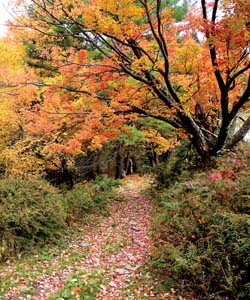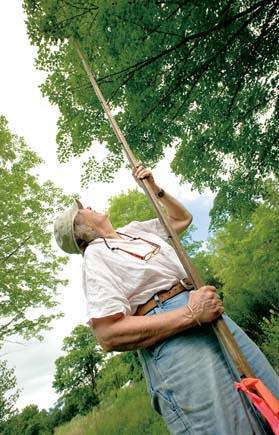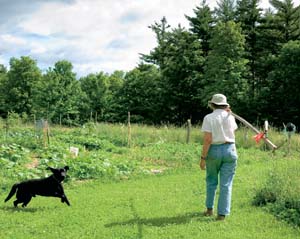 |
 |
| current issue |  | past issues |  | send a letter/news |  | address update |  | advertise |  | about us |  | alumni home |
Features
|
The Quest
Are New England sugar maples in trouble? A citizen scientist goes in search of answers. Online: Martha Carlson '09G appears in a video on The Atlantic website Also read a few facts about sugar maples |
Easy to print version Make a comment |
 Erin Gleason/UNH Photographic Services |
It was the color that had her worried. Martha Carlson '09G had never seen syrup like this before—and she'd been tapping maple trees on her Sandwich, N.H., mountainside property for more than 30 years. In 2009, though, the syrup was dark and glistening, more like molasses than the clear amber liquid she and her husband, Rudy, always produced in their tiny sugar shack. It smelled odd, too, and needed extra filtering, leaving behind a sticky residue. As Carlson tended the evaporator in the shack that March, steam curling around the window frames and out through the roof vent, the air heavy with sweetness, she couldn't stop worrying.
Carlson, who grew up on a Maryland farm, had always paid close attention to the natural world. As an adult, she founded a school with an environmental focus, so she could share her passion with children. And back in the early 1990s, her school was one of the first to participate in the Forest Watch program founded by UNH's Barry Rock, a botanist and forester known for tracking the effects of acid rain and climate change on forest health. Showing her students how to collect and record tree health data for Forest Watch, Carlson became a pioneer in an outreach program that has enlisted thousands of citizen scientists in a regional educational research effort.
Even when she retired from teaching, Carlson never stopped observing her trees. And now, along with the syrup mystery, she began noticing sugar maples with sparse leaf coverage and misshapen leaves. Others were dropping leaves early. She decided she had to do something. So Carlson returned to the classroom—as a graduate student. "Martha was interested in figuring out what kind of 'thermometers' we could use to see if maples are running a fever," says Rock, who is her doctoral advisor. Carlson, who earned a master's degree from UNH in natural resources in 2009, wanted to know if her beloved sugar maples—the ones that flame yellow and orange each autumn, the ones that help to define the character of New England itself—were in danger of disappearing.
 Erin Gleason/UNH Photographic Services/Background by Lisa Nugent/UNH Photographic Services JUST A TRIM: Martha Carlson '09G clips leaf samples from a sugar maple on her farm in Sandwich, N.H. |
One of five species of maple found in New England, the sugar maple (Acer saccharum) can grow to more than 100 feet and live to be 300 to 400 years old. Also prized for its beautiful hardwood, the maple is best known for the sweet sap it produces every spring. While there are no authenticated accounts of how maple syrup was invented, in 1609 French author Marc Lescarbot noted in his Histoire de la Nouvelle-France that the Indians "get juice from trees and distil a sweet and very agreeable liquid, which I have tasted several times." Popular legend holds that it all began when a Native American chief hurled his tomahawk at a tree, which turned out to be a maple. The clear liquid that dripped from the gash was collected by the chief's wife and used to cook venison—and the sweet results were a hit. So, perhaps, began a great New England tradition.
As Carlson pored over old agricultural records and syrup-making journals and interviewed maple syrup producers, her findings confirmed her fear that maple-syrup-making was changing. The old rule of thumb recorded throughout the early 20th century—boil 25 or 30 gallons of sap to make one gallon of syrup—was no longer true. Today that ratio has increased to 40 or 50 to one. And in the lab, where she boiled sap samples in test tubes, Carlson found that the average sugar content has decreased—from 3 percent to 2.2 percent. Noting that the trend in decreasing sugar content parallels a global trend in warming temperatures since the 1970s, she began to wonder about a correlation between the two. Maples need just the right mix of cold springtime nights and warm days for the sap to run. What if warming temperatures were disrupting the cold-thaw cycle, or other stages of tree development, and causing stress to her trees?
 Erin Gleason/UNH Photographic Services |
Carlson has good reason to worry, according to Rock. "Climate change is still being debated in the media, but the huge majority of scientists agree that the problem is starting to run away from us," Rock says, citing NOAA data that shows average winter temperatures in the Northeast have increased by 2.8 degrees since 1971. The 2001 New England Regional Assessment, a National Science Foundation study led by Rock, indicates that temperatures are warming faster than anticipated, and that at the rate things are going, by 2100 the climate in New England could be more like North Carolina's or Georgia's. In the 1950s and '60s, 80 percent of the world's maple syrup came from the United States and 20 percent came from Canada. Today it's just the opposite. "Our New England climate is moving north," says Rock. "We need to get people's attention. If we don't, we're going to be in deep yogurt."
Carlson is worried about more than the economic impact of climate change for maple syrup producers and the fall foliage tourism industry. "We're not just talking about losing a few sugar maples," says Carlson. "We're really talking about losing a dominant species in our forest. That's a scary idea."
Easy to print version
blog comments powered by Disqus

